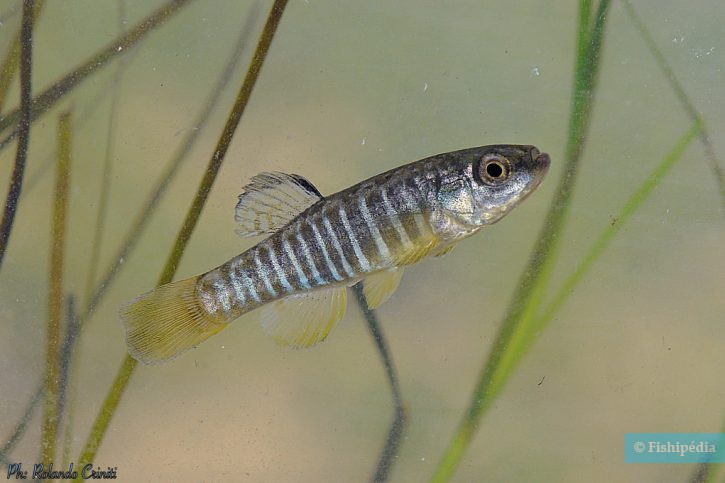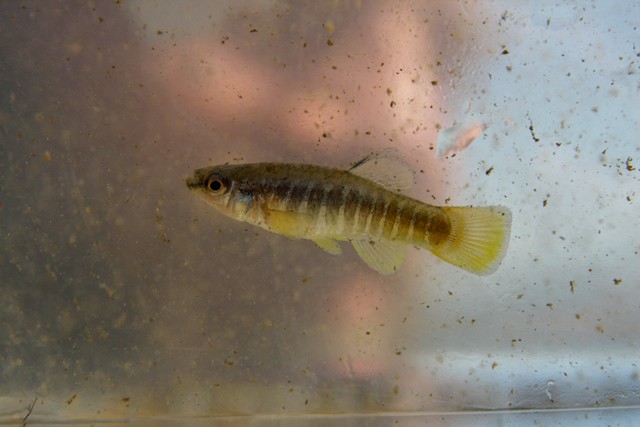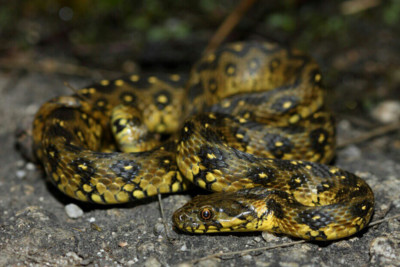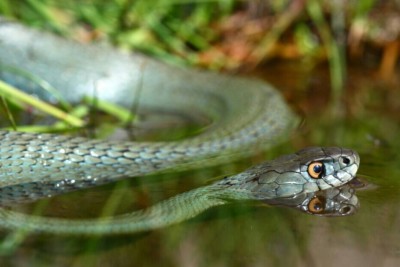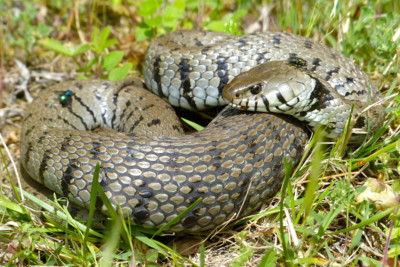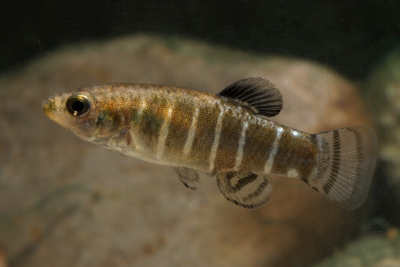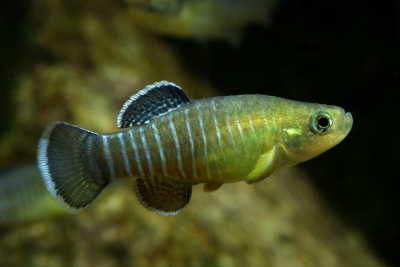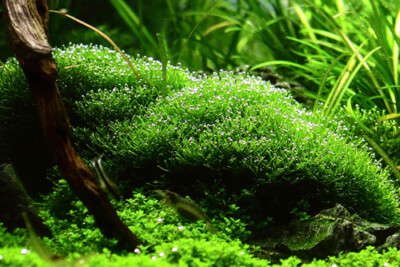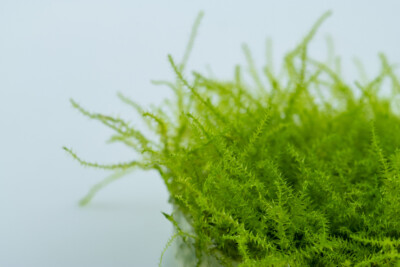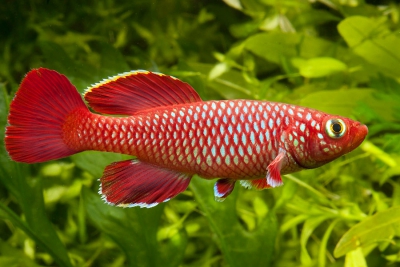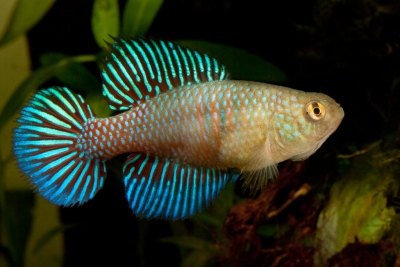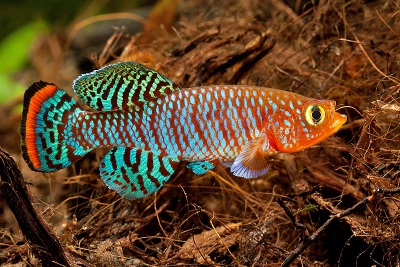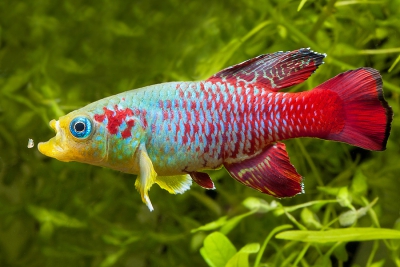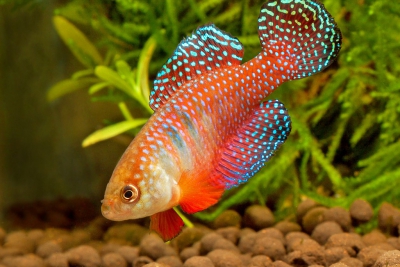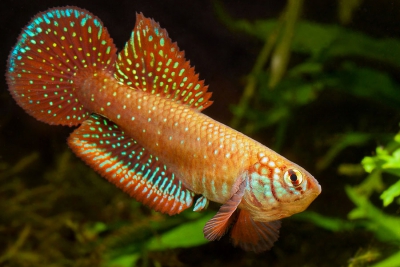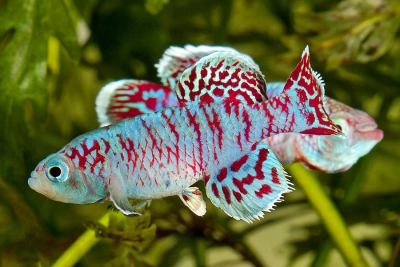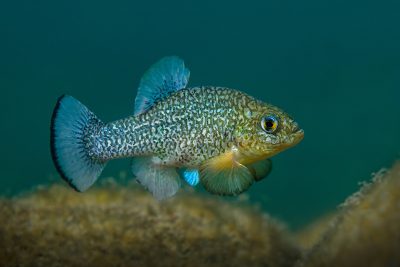mediterranean killifish
| Scientific name | Aphanius fasciatus |
|---|---|
| Descriptor | Valenciennes |
| Year of description | 1821 |
| IUCN category (World) | LC |
| Family | Cyprinodontidae |
| Genus | Aphanius |
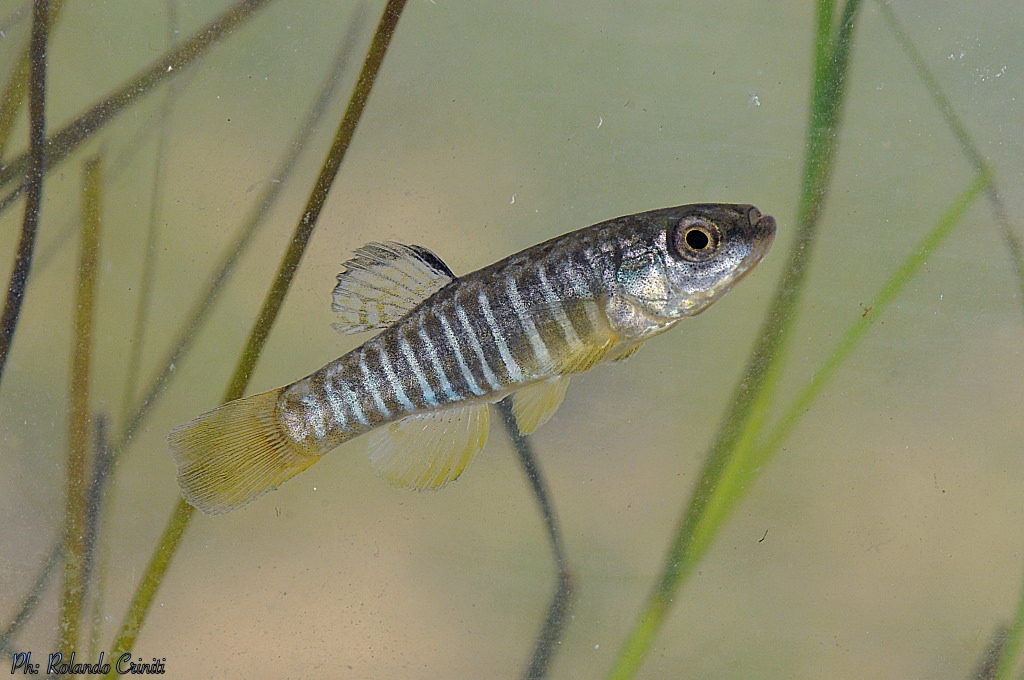

Introduction
The Mediterranean killifish, commonly known as the Mediterranean killifish, is a freshwater fish native to Europe.
Who is it?
Morphology
-
Type
-
Average size5 cm
-
Maximum size6 cm
-
Longevity3 year
-
ShapeOval
-
Type
-
Average size5 cm
-
Maximum size6 cm
-
Longevity3 year
-
ShapeOval
How to recognize This fish ?
The Mediterranean killifish is characterized by a stout body without a distinct lateral line, a flattened head with an upturned proactile terminal mouth.
Its back is green with blue highlights, its body is dark and striped with vertical bands, its belly is silver-white.
Sexual dimorphism
Males are smaller than females, the latter are generally lighter than males and their markings are less contrasting.
The 10 to 12 black vertical bands with blue reflections on the sides of the Mediterranean killifish are more pronounced in males.
Behaviour & Life cycle
-
dietcarnivorous
-
Sociabilityliving in small groups
-
territorialNo
-
Way of livingdiurnal
This species tends to be easily stressed: this uneasiness is characterized by the appearance of marked black bars on its whole body.
The Mediterranean killifish is a social fish that naturally resides at mid-depth and close to the surface.
Although this fish is non-territorial strictly speaking, it can sometimes be aggressive towards other species. The Mediterranean killifish is a polygamous fish that naturally lives in harems. Due to its positioning, it is subject to intense predation by piscivorous birds, such as terns.
Reproduction
-
Reproductionovipare qui enfouit ses œufs
-
PolygamyYes
The Mediterranean killifish is an oviparous fish that buries its eggs.
Harmless species
This species does not represent any particular threats to humans when encountered in its natural environment.
Origin and distribution
Geographic distribution & Conservation
The Mediterranean killifish is found along much of the Mediterranean coast up to Turkey, with the exception of the Iberian Peninsula where it is replaced by the Aphanius iberus.
In mainland France, it was originally found on the Mediterranean coast but has greatly suffered from coastal development. It may still be present in rare protected areas, perhaps in the Camargue. However, it is well established in Corsica.
Its possession is regulated by articles L. 413-1 to L. 413-5 and R. 413-1 to R. 413-51 of the Environmental Code.
Conservation status of populations (IUCN)
What is its habitat?
Natural environment characteristics
-
Temperature10 - 24 °C
-
pH (acidity)6.5 - 7.5
-
gh (hardness)8 - 10
-
FlowSlow and Stagnant
Biotope presentation
The Mediterranean killifish mainly lives in brackish and salty waters (10 to 60g/l of salt). It is particularly found in coastal lagoons and river mouths.
It can survive in extreme conditions of lagoon environments (nighttime anoxia, salinity of 80g/l, temperatures above 35°C). It is sometimes found in enclosed basins like the Amers Lakes on the Suez Canal or Lake Biguglia in Corsica.
Species of the same biotope
Main recommendations for fishkeeping
Deontology
In order to preserve wildlife, if you acquire this animal, it must not be released into the wild. See also, the Fishipedia charter.
Fishipedia supports the practice of responsible and environmentally friendly aquarium keeping. We encourage maintenance if it is motivated by a desire to understand the biological functioning of living things and if it is done with respect for animal life.
We believe that aquaristics is an opening to the discovery of aquatic environments, especially freshwater, and that this knowledge is necessary to better protect and respect these environments. Logically, we refute the compulsive purchase of animals that would not find a sufficient and / or adapted place in the host aquarium.
Our recommendationsThese tips apply to adult species from breeding. With regards to water conditions, wild species or close relatives must be kept under the same conditions as in their area of origin.
-
Min volume60 liters
-
Population min5
-
Temperature10 - 24 °C
-
pH (acidity)6.5 - 7.5
CharacteristicsThe characteristics below apply for adult species. They correspond to an average of cases, validated in maintenance condition.
-
Difficulty breedingThe farming difficulty is relative. It depends on experiments already carried out with similar species. First, it takes into consideration the robustness of the species, the ease of recreation of a favorable environment and the general behaviour with the other inhabitants of the aquarium.hard
-
Robustnesstolerant
-
Behaviourslightly aggressive
-
Availabilityrare
Recommended equipment from our partners
-
Aquarium
-
Filtration
General reminders
It is strongly advised to read the complete dedicated file and to get information on the feedbacks of maintenance of the envisaged animal, this to avoid any potential conflict whose end result is generally the death of the individual (or the other inhabitants). It is important not to overload your aquarium to limit pollution. This will make maintenance easier.
In nature, animals are subject to weather conditions and live in waters with variable characteristics. The recommendations offered by our team for aquarium maintenance are a guidance and cannot be assimilated to scientific datas.
General reminder on maintenance datas
Le démarrage d'un aquarium est une partie primordiale pour l'équilibre et le bien-être des poissons. Lorsque l'on met en eau un aquarium, l'eau passe naturellement par un cycle biologique : le cycle de l'azote. Celui-ci dure environ trois semaines. Tous les 2 jours, nous vous conseillons de tester votre eau jusqu'à ce que le taux de nitrite soit à zéro pendant plusieurs jours d'affilée.
Pour accélérer ce cycle, vous pouvez utiliser un activateur de bactéries comme JBL Denitrol. Cette solution riche en bactéries vivantes et enzymes permet une mise en place rapide du cycle de l'azote. Les poissons peuvent alors être introduits plus rapidement.
Il est important de tester l'eau de son aquarium régulièrement pour maintenir un environnement sain pour les poissons et les autres habitants. Les tests d'eau permettent de mesurer les niveaux de différents paramètres tels que le pH, la dureté totale, ainsi que les taux de nitrates, de nitrites et d'ammoniaque.
Pour réaliser ces tests, vous pouvez utiliser des produits d'analyse spécialisés tels que JBL ProScan qui permet de réaliser un diagnostic de l'eau directement via un smartphone. Il existe également des coffrets de tests plus classiques de bandelettes, comme JBL PROAQUATEST.
En cas d’usage de l’eau du robinet, vous pouvez utiliser un conditionneur d’eau de type Biotopol de JBL pour éliminer les substances nocives comme le chlore, le cuivre, le plomb et le zinc. Les conditionneurs d'eau garantissent une meilleure santé aux poissons et une meilleure croissance des plantes.
Chlorine and chloramine are dangerous for the health of animals. Used to disinfect water, these agents are present in significant quantities in tap water. We recommend using an anti-chlorine agent every time you change the water. In addition to chlorine, treatments and medicines sold for aquarium use sometimes contain dangerous heavy metals in high doses.
Specific needs for the mediterranean killifish
The mediterranean killifish is a species which lives naturally at a temperature between 10 °C and 24 °C. For proper maintenance, the temperature should never exceed the 27°C for long periods. Nitrate levels should remain below 50mg/L. To keep the water clean and unpolluted, plan on changing 20% to 30% of the water volume each month.
The mediterranean killifish is a species whose maintenance is rather reserved for informed aquarists . It can only be successfully carried out by carrying out a minimum of documentation work. Special husbandry conditions can easily lead to the death of the species or other animals.
This species is very rare in the aquarium trade. Instead, it is maintained by knowledgeable aquarists who own and breed individuals from wild origin strains. If you want to get this species, we advise you to contact specialized clubs. }Specimens from long time breeding are a bit easier to breed but you have to respect the particular water parameters.
Heating not required
As this species is used to living in fairly cool water, the presence of a resistance is not necessary in your aquarium. Also be careful to control the temperature of your tank in summer.Cohabitation & Environment
Being a living in small groups fish, it is advisable to install at least 5 individuals in an aquarium of 60 liters minimum. Group maintenance is a prerequisite to ensure their well-being. Lonely individuals tend to quickly become stressed and become especially susceptible to disease. Warning, mixing several species living in the same living area is not recommended if the volume is not significant.
This fish being polygamous, the male must always be maintained with several females. A ratio of three females to one male seems to be a good compromise for the constitution of the group.
The species enjoys a particularly vegetation-rich environment. The addition of plants will provide many useful hiding places for resting. These areas are also conducive to possible breeding in the aquarium.
Tips for feeding
The mediterranean killifish is carnivorous.
This species can eat dry food (flakes, pellets), fresh food and frozen food. To avoid deficiencies, it is recommended to vary the types of food.
You should not overfeed your residents to avoid polluting the water. For most species, it is better to feed a few small portions each day rather than one large meal.
Food recommendations from our partner JBL - Products PRONOVO
-
Granules
-
Flakes
-
Sticks
Reproduction protocol
-
Maintenance difficultymoderate
-
egg-laying protectionNo
Reproduction of this species in an aquarium is considered moderate. Ideally, it takes place at a temperature of around 23 ° C for a pH of 7 .
Hybridization risks
In general, it is advised not to mix several species of the same genus or different varieties of the same species, to avoid the risks of hybridization.
These animals might interest you
These plants might interest you
Plants play a crucial role in aquariums, both for their ability to filter water by absorbing excess nutrients and for their aesthetic contribution. They provide fish with natural hiding places, can serve as breeding sites, and generally help maintain the overall balance and optimal conditions of the aquarium. The selection presented here includes species from the same regions as the species described on this page, although they do not necessarily come from its exact natural biotope.
To go further
Sources & Contributions
Participation & Validation
The Fishipedia team and specialist contributors are committed to providing high-quality content. However, although the information comes from scientific sources or testimonials from specialists, the cards may contain inaccuracies.

Robert Allgayer

Patrick Chartrer

Benoit Chartrer
Translation
Translation done with the valuable contribution of our translators, who make this information available to a wider audience. We sincerely thank them for their commitment.
In collaboration with : Fédération Française Aquariophilie
Bibliographic references
Les Poissons d'eau douce de France - Eric Feunteun - Jean Allardi - Philippe Keith - Biotope Edition - 2011. Collection Inventaires & Biodiversité, publication scientifique du Muséum
Scientific partners
Species of the same family
Same genus
Species of the same biotope
